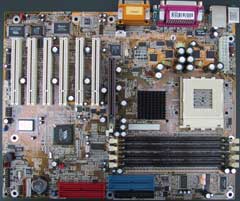VIA KT333 Motherboard Roundup - June 2002
by Anand Lal Shimpi on June 13, 2002 5:41 AM EST- Posted in
- Motherboards
DFI AD76 RAID
|
Motherboard Specifications |
|
|
CPU
Interface
|
Socket-462
|
|
Chipset
|
VIA
KT333 North Bridge
VIA VT8233A South Bridge |
|
Bus
Speeds
|
100/133MHz
|
|
Core
Voltages Supported
|
N/A
|
|
AGP
Voltages Supported
|
N/A
|
|
DRAM
Voltages Supported
|
N/A
|
|
Memory
Slots
|
4
184-pin DDR DIMM Slots
|
|
Expansion
Slots
|
1
AGP Slot
6 PCI Slots |
|
Onboard
RAID
|
Promise
PDC20276
|
|
Onboard
USB 2.0/IEEE-1394
|
VIA
VT6202 (4 USB 2.0 ports)
|
|
Onboard
LAN
|
Realtek
RTL8100L
|
|
Onboard
Audio
|
Avance
Logic ALC650 - 6 Channel
|
DFI has never been a big name in our community simply because they have almost always focused on the OEM market. That path makes business sense as that's where the dollars are, but companies like ABIT have proved the worth of tailoring to the needs of our community.
Thanks to the effort of a former ABIT employee, DFI is changing from an OEM-centric motherboard manufacturer to one that caters to all needs.. Going forward, DFI will be producing two separate motherboard lines, one for their OEM customers and one for the retail channel. The basic design of the two lines will be the same, but the OEM boards will have fewer features, such as little or no overclocking options.
DFI was originally not scheduled to be included in this roundup as their AD76 RAID board was far from ready. We managed to get a preproduction version of the board with a preproduction version of the BIOS in house for this roundup but we'd like to stress that the board is not being sold yet and isn't ready for prime time.

On the feature side, DFI went with a fairly attractive set of options on the AD76 RAID. The six PCI and single AGP 4X slot are commonplace, but the four DIMM slots are a bit out of the ordinary; and unlike the two ABIT boards with 4 DIMM slots, the AD76 worked perfectly fine with all banks populated, regardless of what type of memory we used.
DFI's OEM heritage shines through as you notice that the AD76, much like the ASUS A7V333, doesn't use any active cooling for the North Bridge. The main difference between the AD76 and the ASUS A7V333, however, is that DFI's heatsink has much less surface area and we question how effective it is in comparison to ASUS' solution.
Despite being late to the game with their KT333 board, DFI did not choose to outfit the AD76 with the ability to read from the Athlon XP's on-die thermal diode. An external thermistor rests in the center of the CPU socket which, like most external thermistors, provides grossly inaccurate temperatures and doesn't offer any serious thermal protection options.
As is the case with most of the manufacturers in this roundup, DFI outfitted their board with an external VIA USB 2.0 controller. This won't be necessary when DFI releases their KT400 board as the 8235 South Bridge has VIA USB 2.0 core built in, but until then DFI and the rest of the group have to resort to external controllers.
Other than USB 2.0 support, the board also offers AC'97 audio using the ALC650 codec and 10/100 Ethernet through a Realtek controller. The two Ultra ATA 133 RAID ports are powered by Promise's PDC20276 controller, which has the same stripe size limitations we mentioned on the ASUS A7V333 page.
Since the Voodoo5, we've never had an AGP graphics card as long as the GeForce4 Ti 4600 and thus we've never run into issues with components blocking a 3/4 length AGP card. In the case of the AD76, the position of the primary and secondary IDE connectors can cause problems with a Ti 4600 installed. With cables installed in one or more of those connectors they can push up on the bottom of the Ti 4600 preventing the card from sitting properly in the slot. We were still able to conduct our tests, but DFI should definitely move those connectors to the right about half an inch.
Because the BIOS was preproduction, a bunch of debugging options were present that should be removed in the final version. There were no selectable FSB settings, no voltage and no multiplier controls offered in the BIOS either.
As we mentioned before, despite the board's preproduction state, it exhibited no stability issues even with all four DIMM slots populated. The board would not function properly if the on-board audio was enabled, which is an issue that will hopefully be fixed by the time it ships.











0 Comments
View All Comments